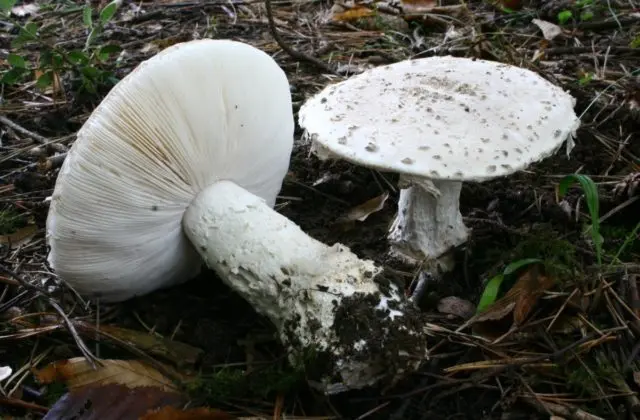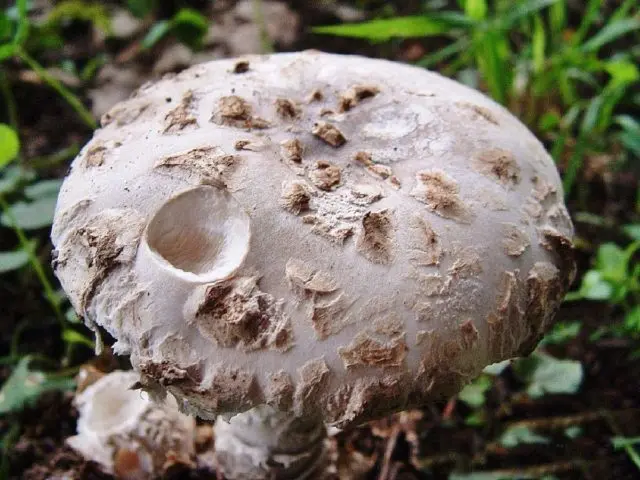Contents
Pineal fly agaric is a rare representative of conditionally edible mushrooms of the Amanita family (another name is Amanitovye). Like all his fellows, he has a characteristic cap, covered with small white warts – the remains of the shell. Mostly the fungus grows on alkaline soils of mixed forests of the European continent. This is a fairly large and conspicuous representative of the family. The pineal fly agaric is a rare species.

Description of the cone-shaped fly agaric
Outwardly, the pineal fly agaric resembles an ordinary red one. The main differences are only in the color of the hat. In this species, it has a gray or white color. The height and other dimensions of fruiting bodies are approximately the same.
The cone-shaped fly agaric has a lamellar hymenophore characteristic of the Amanitic. It grows mainly in mixed forests, forming mycorrhiza with spruce, oak or beech. Prefers sunny areas with rich soils. A photo of the pineal fly agaric is presented below:

Cap Description
The cap has a diameter of 5 to 16 cm. Like all Amanites, at the beginning of the life cycle of the fruiting body, it has the shape of a hemisphere. Further, it is straightened, and it gradually becomes first convex, and then almost flat. Over time, the cap of the pineal fly agaric bends even more, a notch appears in it.

Description of the leg
The leg of the pineal fly agaric has a cylindrical shape, sometimes tapering towards the top. In some cases, there is a significant thickening of the legs at the base. Its length can reach 16 cm, and its diameter can reach 3,5 cm.

Along the entire length, the leg is covered with “flakes”, consisting of many scales lagging behind the pulp. One gets the impression that they form a kind of tile. The stem is equipped with the same flaky ring, which falls off after the edges of the cap are bent upwards. When the stem is cut, the color of the flesh does not change in the air.
Twins and their differences
All representatives of the Amanitov family are very similar to each other. Therefore, we can safely say that the pineal fly agaric is easy to confuse with any other mushroom from this group. Almost all members of the family are poisonous mushrooms, so you should be very careful not to let them fall into the basket when collecting.
saffron float
Another name is saffron fly agaric. Most often, this twin is found in mixed forests on soils with high humidity. Forms mycorrhiza with birch, oak and spruce.
The size is slightly smaller than the cone-shaped, the cap is from 3 to 12 cm in diameter. Its color can vary from bright orange, making it look like a classic red fly agaric, to light cream.

The entire surface of the cap is shiny, covered with small warts. The leg is up to 15 cm long, no more than 2 cm in diameter. It has a cylindrical shape, slightly narrowed at the top. The fungus has almost no smell.
It is considered a conditionally edible mushroom of good quality. Raw poisonous, requires mandatory boiling for at least 30 minutes. It is not subject to storage, mushrooms must be processed immediately after collection.
Amanita muscaria
A poisonous mushroom, which is more dangerous than the classic red, because it has a 2-4 times higher concentration of toxins. Outwardly, it resembles all members of the family, however, it is smaller and has a characteristic coloring feature. The cap of this species is colored light brown.

The diameter of the cap rarely exceeds 10 cm. The height of the stem can reach up to 13 cm, and the width is up to 1,5 cm. The stem always has a conical shape – from below it has a tuberous swollen base. The ring on the stem exists throughout the life of the fruiting body.
Fly agaric tall
Another pleasant exception to the Amanitaceae: this species is also edible. It grows in almost all forests of the Middle Strip. The diameter of the cap reaches a record 25 cm, the weight of one specimen sometimes exceeds 200 g.

The difference from many similar species are rather large flakes on the cap, which are not characteristic of either panther or red fly agarics. On the other hand, since the mushroom looks very similar to many other poisonous varieties, it is not recommended to collect it in order to avoid accidents.
Where and how does the pineal fly agaric grow
The fungus is found in only a few places on the planet, quite distant from each other. It can only be found in certain regions of Eurasia:
- on the west coast of France;
- on the border of Latvia and Estonia;
- in the eastern part of Georgia;
- on the south of Ukraine;
- in Novooskolsky and Valuysky districts of the Belgorod region;
- in the center and east of Kazakhstan.
On other continents, the pineal fly agaric is not found. The fungus never grows on acidic soils, and also does not tolerate too harsh climates. It is considered a very rare species listed in the Red Book.
In mixed forests, it mainly grows on the edges and near paths. In most cases, it is much less common. In deciduous forests, it can be found almost anywhere. Usually grows in small groups, solitary fungi are almost never observed.
Edible pineal fly agaric or poisonous
The debate about whether this mushroom can be eaten has not subsided so far. Formally, it is not poisonous, it belongs to conditionally edible. But it cannot be consumed raw, because without heat treatment its effect on the body is similar to the red fly agaric. You can eat pineal fly agaric only after heat treatment (boiling) for at least half an hour.
Symptoms of poisoning and first aid
Symptoms of intoxication are similar to the red fly agaric. This is the so-called 2nd type of poisoning. It manifests itself 0,5-6 hours after eating mushrooms and has the following manifestations:
- nausea, vomiting, diarrhea, abdominal pain;
- copious salivation;
- sweating;
- constriction of the pupils.
If the poisoning has become severe, the following symptoms are added to the symptoms:
- shortness of breath, separation of bronchial secretions;
- drop in heart rate and blood pressure;
- dizziness, confusion, hallucinations.
In the event of the appearance of such symptoms, it is necessary to call an ambulance as soon as possible and try to remove the toxic substances contained in the mushrooms from the body.
In order to induce vomiting, it is necessary to provide the victim with a plentiful drink (warm salt water in an amount of up to 2 liters) and press a finger on the root of the tongue. It is advisable to repeat the procedure several times, after which give activated charcoal in the amount of 1-2 tablets per 1 kg of weight.
Interesting facts about the pineal fly agaric
Of the interesting facts about the mushroom in question, several can be noted. First of all, this is the disjunctive area of its distribution, which has already been mentioned. Despite the sufficient remoteness of local distribution sites, mushrooms in each of the habitats retain the same size and appearance.

Another interesting feature of the pineal fly agaric is its love for alkaline soils. This is not typical of the “indigenous” inhabitants of the European continent, which has predominantly acidic soils. It is possible that the fungus is of North American origin, in some random way its spores came to Europe, although its population is not currently recorded in North America.
Another possibility, explaining both the disjunctive range and calcification, may be that the pineal fly agaric is endemic to the coast of the Bay of Biscay, accidentally spreading through Europe.
In addition, due to the low content of muscimol and ibotenic acid (concentrations are approximately 5-10 times lower than those for the red fly agaric), the mushroom is difficult to classify as hallucinogenic. This opens up its use in traditional medicine without serious consequences for patients. Dried mushrooms are used to treat open wounds. In addition, a decoction of dried mushrooms is used in the treatment of joint pain, migraines, and cancer.
And, of course, like all fly agarics, the pineal has insecticidal properties. In areas where the fungus grows, flying insects are practically not found. Alkaloids of the fungus, dissolved in water, cause them a long-term sleep, lasting up to 12 hours. During this time, unlucky arthropods who decide to drink water from fly agarics become prey for ants, hedgehogs or birds.
Conclusion
Pineal fly agaric is a rare mushroom of the Amonite family, which, due to the low concentration of toxins, is classified as conditionally edible. It has a discontinuous range and grows only in those places where the necessary conditions exist for it: alkaline soil and relatively mild winters. Thanks to its constituent substances, the mushroom is used in folk medicine.









